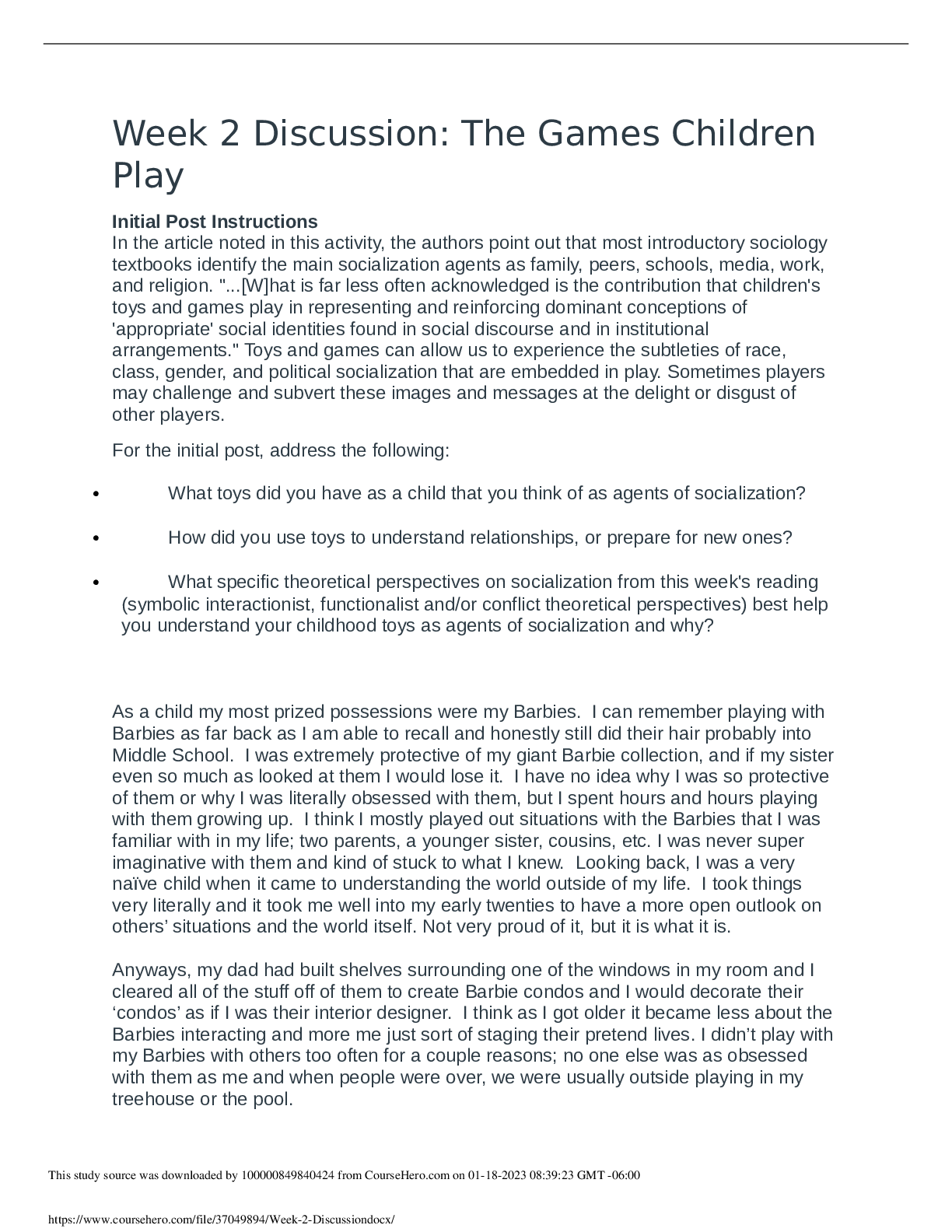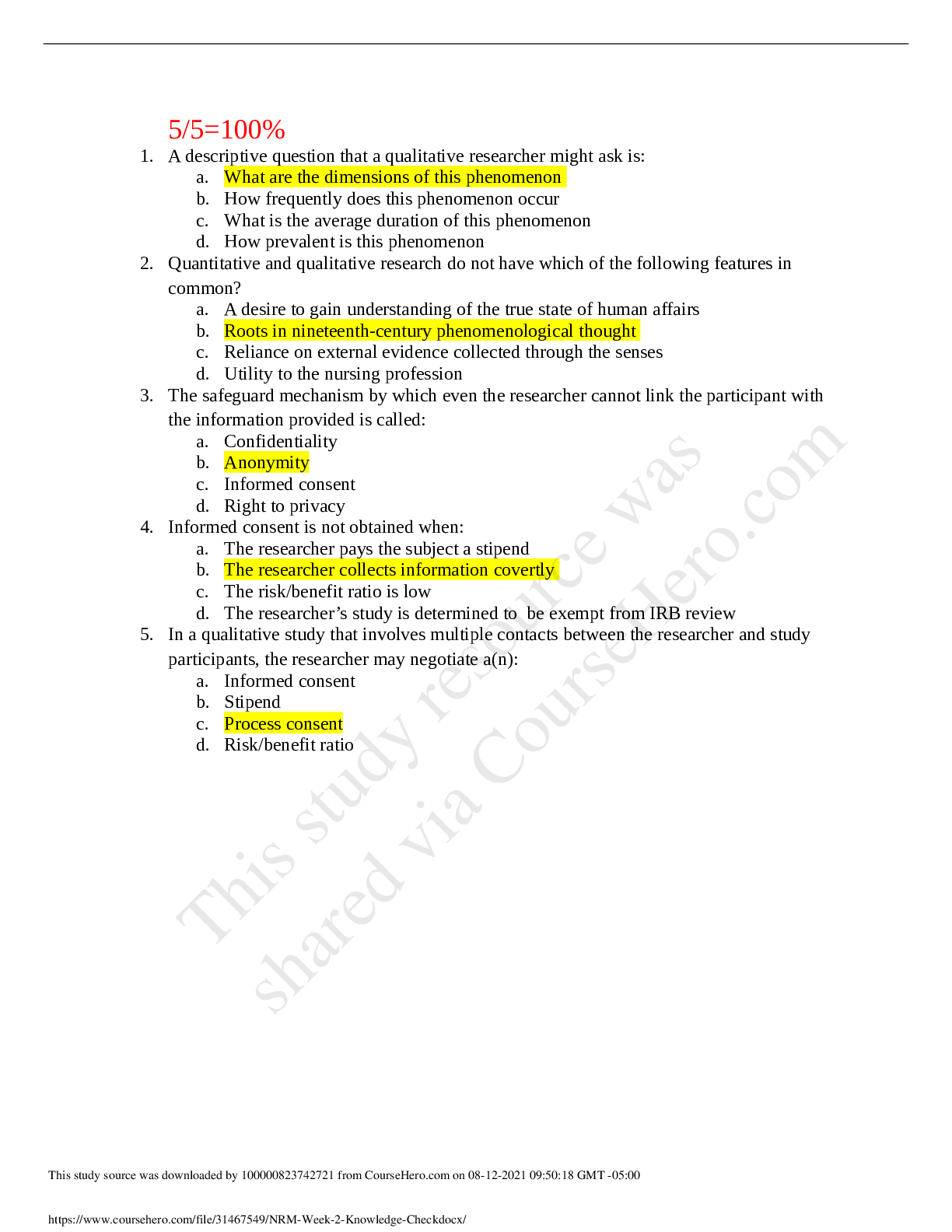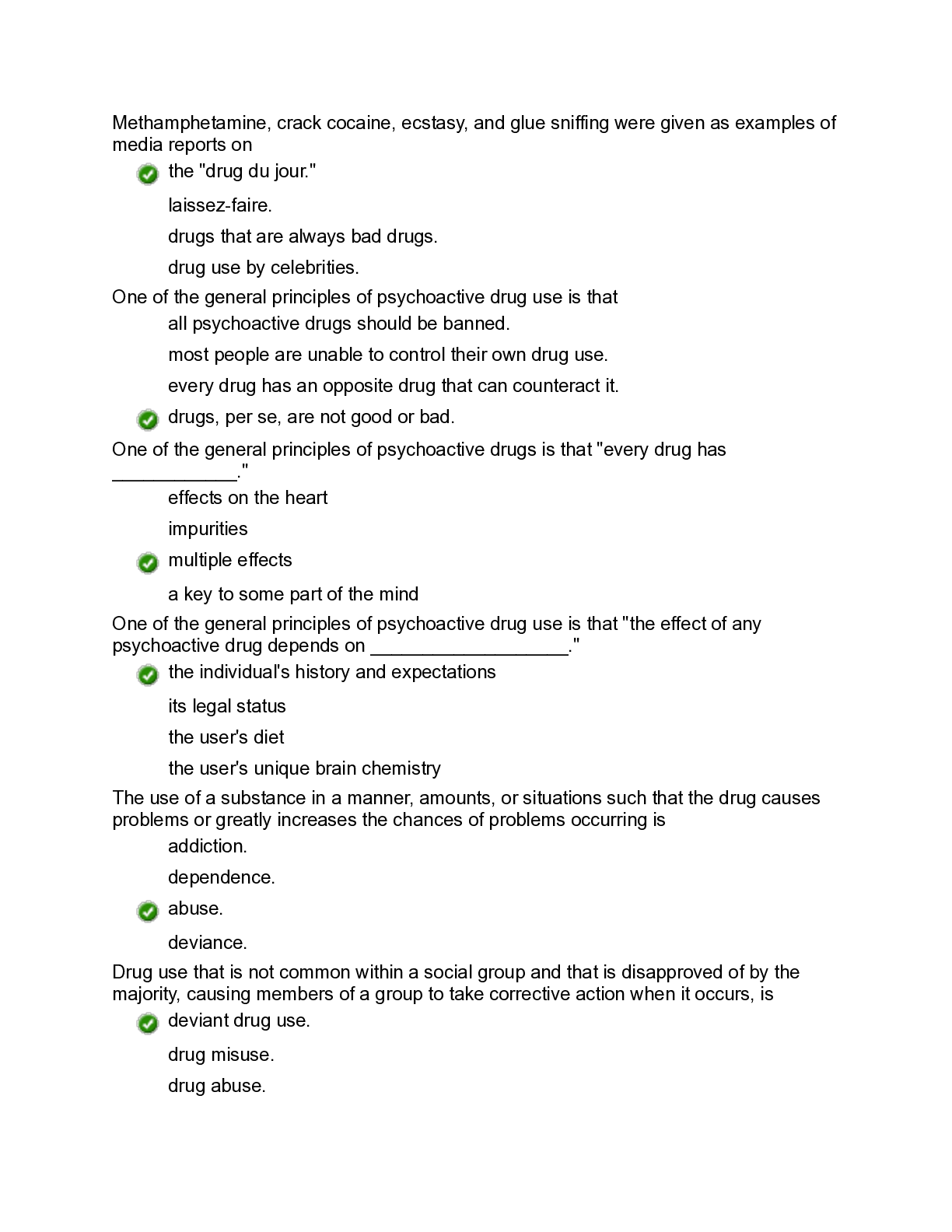Physiology > QUESTIONS & ANSWERS > Camden County College PSY 101: 8 :PSYCHOSOCIAL DEVELOPMENT IN EARLY CHILDHOOD (All)
Camden County College PSY 101: 8 :PSYCHOSOCIAL DEVELOPMENT IN EARLY CHILDHOOD
Document Content and Description Below
Answer: A Page: 269 Guidepost: 1 Type: F 1. The sense of self, or the knowledge of who we are and who we want to be, is called A. self-concept B. self-awareness C. self-definition D. ideal se... lf Answer: B Page: 269 Guidepost: 1 Type: C 2. When children incorporate into their self-image their growing understanding of how others see them, they are experiencing A. cognitive development B. social development C. physical development D. psychological development Answer: D Page: 270 Guidepost: 1 Type: C 3. When a 4-year-old boy is asked to describe himself, he will typically tell you about his A. relational self B. real self C. descriptive self D. ideal self Answer: B Page: 270 Guidepost: 1 Type: F 4. In neo-Piagetian terminology, this is the first stage in development of self-definition, in which children describe themselves in terms of individual, unconnected characteristics and in all-or-nothing terms. A. deductive B. single representations C. representational mappings D. ideal self Answer: C Page: 270 Guidepost: 1 Type: C 5. Which of the following is a part of self-definition? A. recognizing oneself B. parental values C. developing a concept of the ideal self D. developing a concept of self-centeredness Answer: D Page: 270 Guidepost: 1 Type: C 6. Understanding their emotions helps children to do all of the following except A. guide their behavior in social situations B. control the way they show their feelings C. allows them to talk about their feelings D. allows them to control all social situations Answer: D Page: 271 Guidepost: 1 Type: C 7. According to research on children’s understanding of emotions, how do 4-year-olds feel about themselves if they do something that has been forbidden by their parents? A. They feel shame whether or not their parents see them perform the forbidden act. B. They feel shame only if their parents see them perform the forbidden act. C. They feel shame only if their parents punish them for performing the forbidden act. D. They feel no shame, even if their parents saw them perform the forbidden act. 136 Answer: B Page: 271 Guidepost: 1 Type: F 8. At what age do children first begin to take pride in their accomplishments even when no one is around to see them doing something well? A. 4 to 5 years B. 7 to 8 years C. 10 to 12 years D. 13 to 15 years Answer: A Page: 271 Guidepost: 1 Type: F 9. According to the text, which of the following is a reason for the difficulty that 5- year-olds have in understanding their own emotions? A. They do not recognize that they can experience different emotions at the same time. B. They only experience strong emotions when others around them show emotions. C. They don’t realize that anyone besides them actually has emotions. D. They do not understand that emotions depend on innate, temperamental factors. Answer: B Page: 271 Guidepost: 1 Type: C 10. Only after children gain self-awareness and accept the behavior their parents have set will they begin to develop all but which of the following emotions? A. guilt B. love C. shame D. pride Answer: C Page: 271 Guidepost: 1 Type: F 11. According to Erikson, which of the following is the central issue of early childhood? A. trust versus mistrust B. autonomy versus shame and doubt C. initiative versus guilt D. identity versus role confusion Answer: A Page: 272 Guidepost: 2 Type: F 12. According to Erikson, the conflict between young children’s urge to pursue goals and their moral judgements about those urges is A. initiative versus guilt B. autonomy versus shame and doubt C. industry versus inferiority D. identity versus role confusion Answer: B Page: 272 Guidepost: 2 Type: C 13. Four-year-old Marcie has decided that she would like to hide her little brother’s toys in the basement. However, she realizes her brother will cry, and she wonders if she will feel bad about this. According to Erikson, Marcie is experiencing the conflict of A. identity versus role confusion B. initiative versus guilt C. purpose versus will D. industry versus inferiority Answer: B Page: 272 Guidepost: 2 Type: F 14. The virtue acquired through successful resolution of Erikson’s third developmental crisis (initiative versus guilt) is A. hope B. purpose C. trust D. will Answer: D Page: 272 Guidepost: 2 Type: F 15. According to Erikson, a child who feels comfortable trying new things, without excessive guilt or fear, is said to have acquired A. virtue of will B. virtue of hope C. virtue of trust D. virtue of purpose 137 Answer: C Page: 272 Guidepost: 2 Type: F 16. The judgment young children make about their self worth is called A. self-concept B. self-definition C. self-esteem D. self-recognition Answer: C Page: 272 Guidepost: 2 Type: C 17. According to research, at what age would one expect a young child’s self-esteem to be based on a somewhat realistic appraisal A. before 5 years of age B. before 7 years of age C. before 9 years of age D. before 11 years of age Answer: A Page: 273 Guidepost: 2 Type: F 18. When personal self-esteem is , a child is motivated to achieve. A. high B. low C. medium D. absent Answer: D Page: 273 Guidepost: 2 Type: C 19. Children with high self-esteem A. attribute failure to themselves B. attribute disappointments to their own choices C. move on when they fail and do something different D. persevere and develop strategies that will provide success Answer: B Page: 273 Guidepost: 3 Type: F 20. Gender refers to A. role-learning B. what it means to be male or female C. identification with parents D. friendship patterns between males and females Answer: B Page: 273 Guidepost: 3 Type: F 21. Psychological or behavioral differences between males and females are A. sex differences B. gender differences C. gender stereotypes D. noticeable only after 3 years of age [Show More]
Last updated: 1 year ago
Preview 1 out of 17 pages

Reviews( 0 )
Document information
Connected school, study & course
About the document
Uploaded On
Aug 10, 2021
Number of pages
17
Written in
Additional information
This document has been written for:
Uploaded
Aug 10, 2021
Downloads
0
Views
50



.png)



.png)




.png)





.png)

.png)




.png)
.png)

.png)



